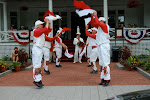It all began in the beginning, and continued onward from there. Or so it is said. The origins and purpose of Morris Dancing remain shrouded in history/mystery, but we know for sure that it began somewhere, and somehow.
The general belief is that Morris Dancing originated in the villages of England as a pagan springtime ritual performed to entice Mother Nature to provide fertility in the fields and a bountiful harvest. Sticks, hankies, ribbons, and bells were symbolically used to chase away the winter spirits and prepare the earth for the spring planting. While there were many varied types of vernal celebrations throughout England, it is the general style of dancing from the Cotswolds region that somehow crossed the Atlantic (with bells on) and evolved into what has become American Morris Dancing. While looking back to the villages of England to adopt an initial “tradition” to follow, American teams develop their own kit, or costume, and their own way of interpreting the dances of their tradition, thus continuing the evolution of a folk art form that has existed for centuries. (The first recorded reference to Morris Dancing was in the 12th century, and some villages in England claim their teams have danced continuously for over 300 years). Other forms of Morris are also found in the States, including clogging, longsword and rapper dancing, Molly dancing, and Border Morris, a looser form of Morris hailing from the Welsh border.
Morris Dancing season traditionally begins in New England on May Day and runs through the summer solstice when the heat and humidity catch up. Teams in different areas of the country as well as the world (yes, we’re global) celebrate at different times of the year depending on their own holidays and seasons. In the Cotswolds of England, dance season begins on Whitsun, or Spring Bank Holiday, the last Monday of May, which coincides with our Memorial Day.
It needs to be said that there is a less romantic view on the origins of this ancient springtime ritual. It is rumored that Morris dancing was initially performed by rough hewn field hands and laborers who developed the dance to accompany the already existing springtime celebrations. The incentive was to pass the hat amongst the crowd for ale money. The notion that the donor would receive good luck for a year was created to generate more funds for ale.
As is the American way, we have managed to preserve and blend both of these theories as we dance for the crops and for our ale as well. Pub stops are traditional while on Morris tour, as is passing the hat, as we honor the thirst of our farm-implement-yielding English forebears. Farmers markets, street corners and festivals are all fair game for the merry Morris, but don’t be surprised to hear the ringing of many bells as you stroll along the river one spring day. It’s just the Morris Dancers, and the spring fairies calling back to them.
Louise Levy







No comments:
Post a Comment